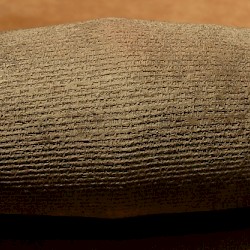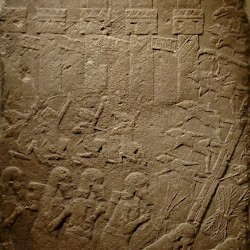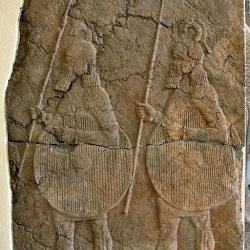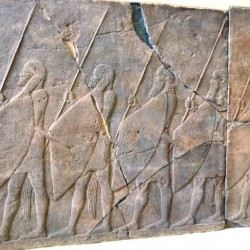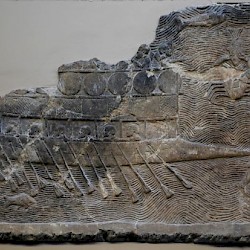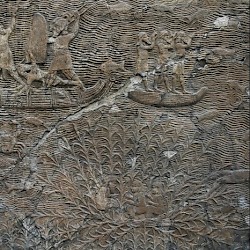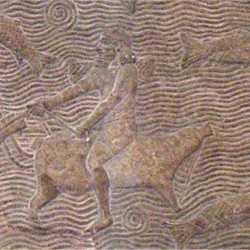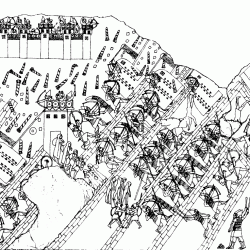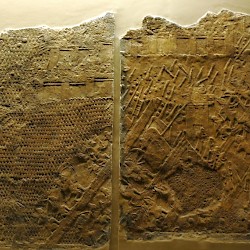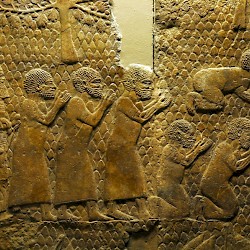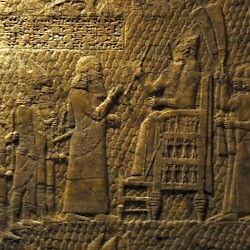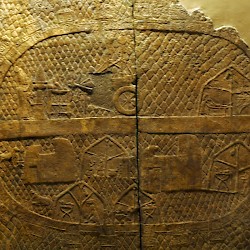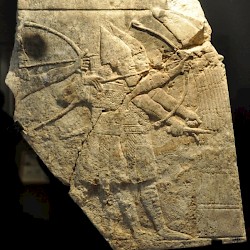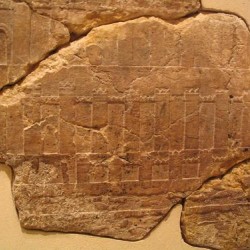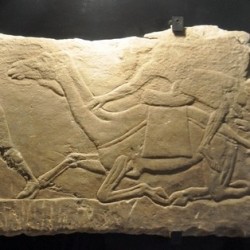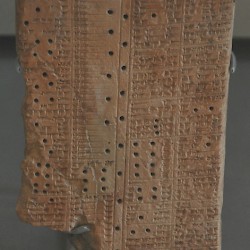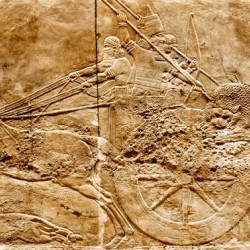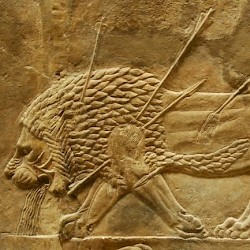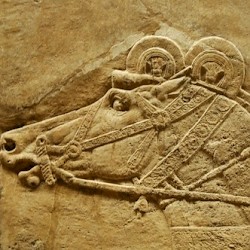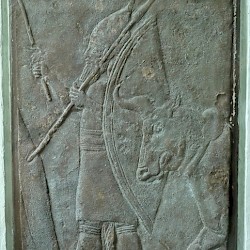Nineveh (Mosul)
Q5680Nineveh (Assyrian: Ninua): last capital of the Assyrian Empire, destroyed in 612 BCE, modern Mosul.
Early History
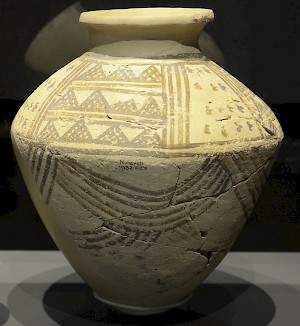
Nineveh, the last capital of Assyria, is situated on the east bank of the river Tigris, at the place where this stream is joined by the small river Khosr, which divides the town into a northern and a southern half. Both halves have a citadel close to their west wall: the southern hill is called Nebi Yunus ("prophet Jonah") after the old Islamic mausoleum on that site, while the northern hill is called Kuyunjik.
The most ancient remains in Nineveh date back to the seventh millennium BCE. There is some splendid pottery, but little is known about this very early period.
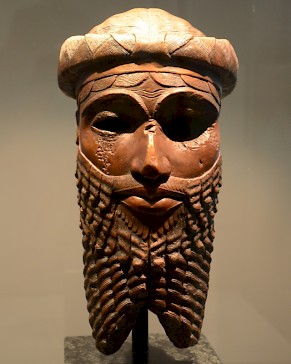
What is reasonably clear, however, is that in the second millennium, Nineveh was already a town of some importance with an important sanctuary, dedicated to the goddess Ištar. Among the finds is a famous portrait of an Akkadian king, often identified with Sargon the Great (c.2300 BCE), but in fact representing his son Maništušu (c.2250 BCE).
The town must have been a station along the great road that connected Elam, Babylonia, and Assyria with Anatolia. There is evicence for extensive building by (a/o) kings Šalmaneser I (r.1263-1234 BCE) and Tiglath-pileser I (r.1114-1076 BCE).
In those days, the Assyrian capital was Aššur, which remained the residence of the king until in the ninth century BCE, when Kalhu (modern Nimrud) became the capital. King Sargon II (r.721-705) replaced Kalhu by Dur Šarrukin (Khorsabad), and his son and successor Sennacherib (r.704-681) moved the administrative center to Nineveh.
Sennacherib's City
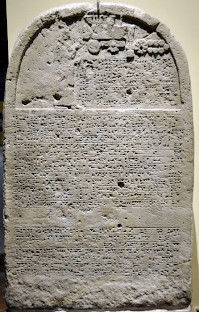
Sennacherib describes his building activities in a stele, which today can be seen in the Istanbul Archaeological Museum:
I made its market-streets wide enough for a royal road and made the road shine like the day.
The wall and outer wall I caused to be skillfully constructed and raised them mountain high. I widened it most to 100 great cubits (c. 50 meters).
In days to come, that there might be no narrowing of the royal road, I had stelae made which stand facing each other. 52 great cubits I measured the width of the royal road, up to the Park Gate. If ever anyone of the people who dwell in this city tears down his old house and builds a new one, and the foundation of his house encroaches upon the royal road, they shall hang him upon a stake over his house.
The brick wall of Nineveh had a circumference of some twelve kilometers and surrounded an area of 720 hectares. (Compare the Servian Wall of Rome: eleven kilometers.) There were fifteen gates. To make sure there was enough water, a canal with a length of ninety-five kilometers was dug, which included an aqueduct at Jerwan, some 65 kilometers upstream from Nineveh. The city of Sennacherib may have had some 100,000 inhabitants.
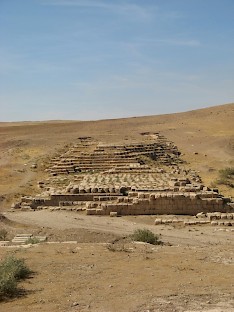
On Kuyunjik hill (north of the river Khosr), Sennacherib built his "palace without rival", which is also known as the "southwestern palace" and measured about 500 x 250 meters, comprising about eighty rooms. There were many reliefs, including one that shows the capture of Lachish in Judah in 701 BCE, an event also known from the Bible.note
On the Nebi Yunus hill, Sennacherib's son and successor Esarhaddon (r.680-661) would build an arsenal, which appears to have been built over another palace. This older structure was discovered in 2017 and real research has not yet taken place, but if the arsenal was indeed built over the palace, it must date back to the reign of Sennacherib or must be older.
Aššurbanipal's City
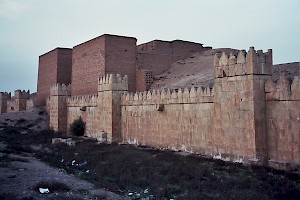
Esarhaddon's successor Aššurbanipal (r.668-631) built a second palace on Kuyunjik, usually called the "northern palace". It replaced an older palace, "the house of succession", which had until then been inhabited by the crown prince.
The northern palace is famous for the reliefs of the lion hunt. The equally famous "Library of Aššurbanipal" is in fact a collection of more than 30,000 tablets found on various locations and not a real library. It offered modern scholars a first glimp of Mesopotamian literature.
The End
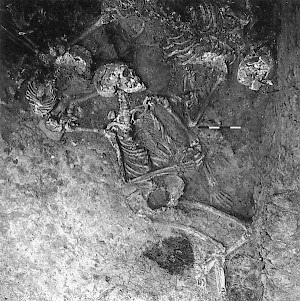
In 612 BCE a coalition of Babylonian and Median troops sacked Nineveh, an event described in the Fall of Nineveh Chronicle. It must have been a difficult campaign, because the city could not be approached from the west, where it was protected by the Tigris, while it was protected by the very impressive "wall whose splendor overwhelms the enemy" on the other sides. The last Assyrian armies made their last stand in Harran. The Biblical prophet Nahum is the only source that documents joy about the fall of the city.
Although this was the end of the Assyrian Empire, it was not the end of Nineveh. In 401 BCE, the Greek mercenary leader Xenophon stayed in a place called Mespila,note and his description is sufficiently accurate to identify the town as Nineveh. Today, the name "Mespila" is rendered as "Mosul".
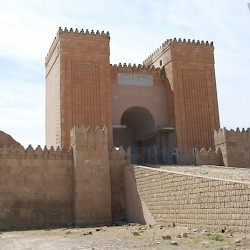 Nineveh, Nergal Gate |
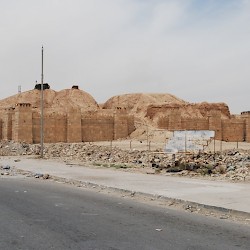 Nineveh, Šamaš Gate |
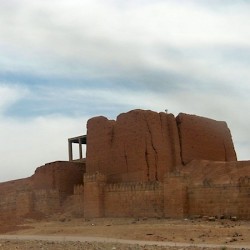 Nineveh, Adad Gate |
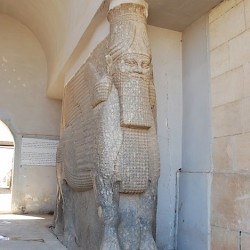 Nineveh, Nergal Gate, Lamassu |
Later History
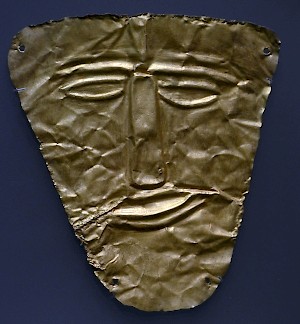
Archaeological finds from tombs document the survival of Nineveh in the Parthian age. Writing at the beginning of the common era, Greek geographer Strabo mentions the city and its plain.note The Greek author Philostratus refers to a Damis of Nineveh, who was the companion of the first-century CE philosopher Apollonius of Tyana. In 627 CE, Nineveh was the site of an important battle between the Byzantines and Sasanian Persians. The city was abandoned after the Mongol invasion in the thirteenth century.
In the Greek tradition, there were several legends about Nineveh, its founder Ninus, and its queen Semiramis, but these stories contain little historical information and make no clear distinction between Assyria and Babylonia.
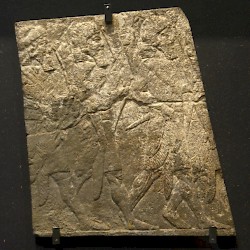 Nineveh, Relief of Assyrian archers |
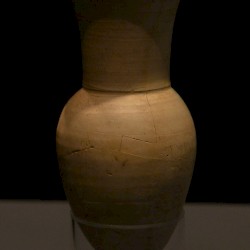 Nineveh, Cup |
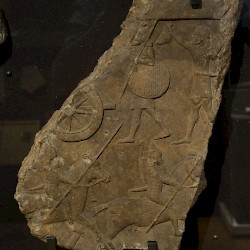 Nineveh, Palace of Senacherib, Victory scene |
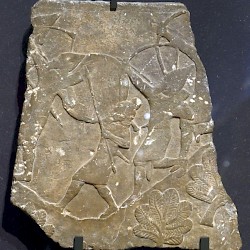 Nineveh, Relief of Assyrian archers |
